Libyan Desert Glass is a rare and intriguing natural phenomenon with a history dating back thousands of years. It is a type of tektite, which is a form of natural glass that forms when a meteorite strikes the Earth’s surface, melting and vaporizing the surrounding rock, and then solidifying as glass.

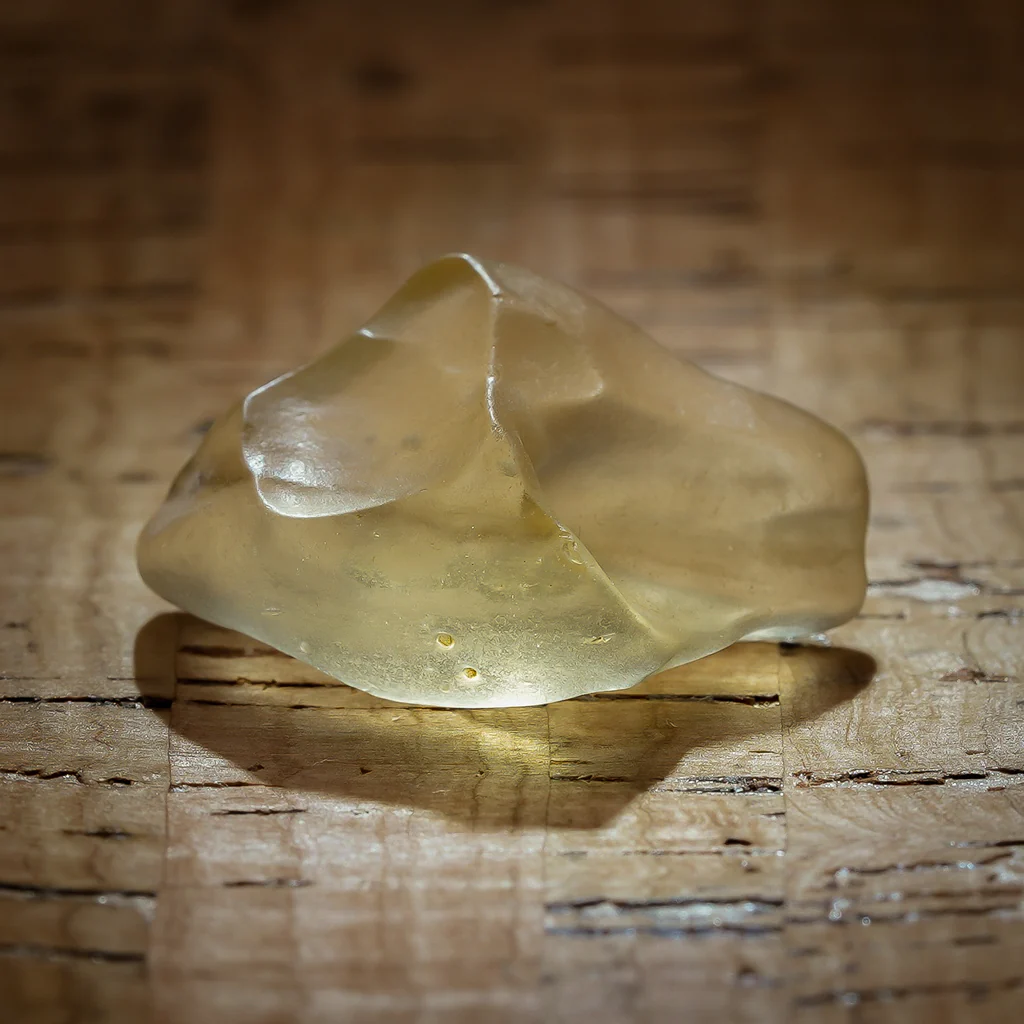
Definition and Overview: Libyan Desert Glass, often referred to as LDG, is a translucent to opaque yellow-green natural glass that is found scattered across the eastern Sahara Desert in Egypt and Libya. This unique glass is believed to have formed about 29 million years ago, during the late Eocene epoch, when a significant meteorite impact occurred in this region. The intense heat and pressure generated by the impact event caused the local sand and rocks to melt and fuse, resulting in the formation of Libyan Desert Glass.
Libyan Desert Glass is characterized by its distinctive, bright yellow to green color, and it varies in size from small fragments to larger pieces that can weigh several kilograms. Its smooth and often polished surface makes it visually striking, and it has been used for both scientific research and jewelry making due to its unique properties and appearance.
Geographic Location and Distribution: Libyan Desert Glass is primarily found in two remote areas within the eastern Sahara Desert:
- Great Sand Sea: The majority of Libyan Desert Glass is located within the Great Sand Sea, which is part of the Libyan Desert in Egypt. This vast, uninhabited desert region covers an area of over 72,000 square kilometers and is home to numerous LDG fragments scattered across the sand dunes.
- Libyan Desert: Some Libyan Desert Glass fragments are also found in the Libyan Desert of western Egypt and eastern Libya. These areas are even more remote and less explored than the Great Sand Sea.
The glass is not evenly distributed and is often found as individual fragments rather than in concentrated deposits. Locating Libyan Desert Glass specimens can be a challenging and adventurous task due to the harsh desert environment and the lack of infrastructure in these remote regions.
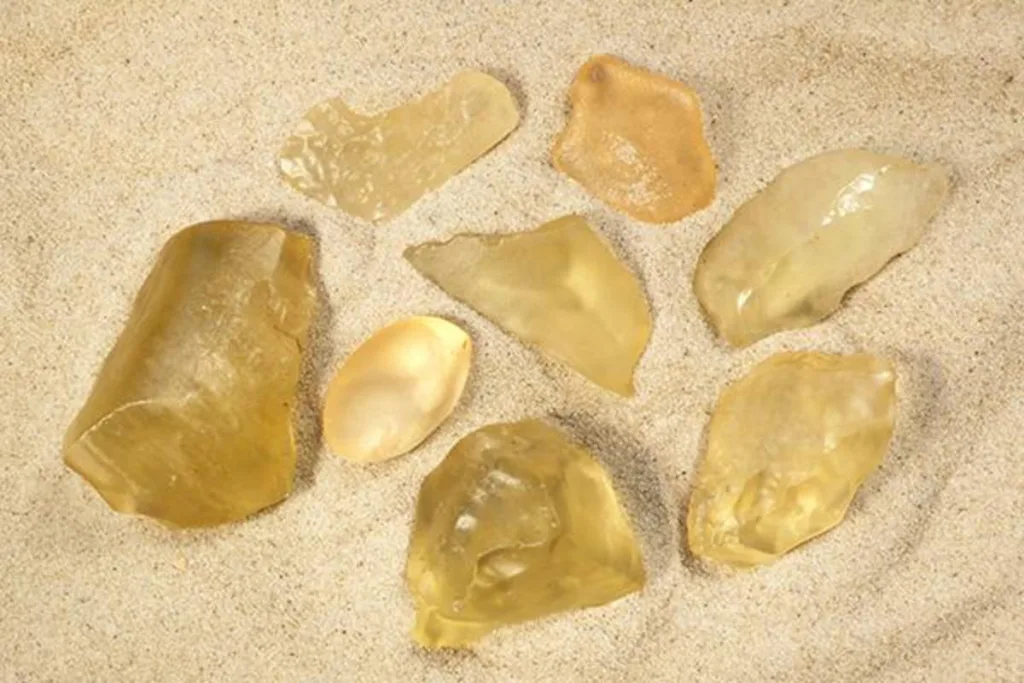
Historical Significance: Libyan Desert Glass has held historical and cultural significance for thousands of years. Ancient Egyptians used it to craft jewelry, including beads, pendants, and other ornaments, which have been found in archaeological sites dating back to as early as the Middle Kingdom (around 2000-1700 BC).
The ancient Egyptians referred to Libyan Desert Glass as “the rock of god” and believed it to have mystical and protective properties. This glass was often used in the making of scarabs and amulets, which were worn for protection and good luck.
In addition to its historical significance, Libyan Desert Glass has also attracted the attention of researchers and scientists. It has provided valuable insights into the geological history of the Earth and the impact events that shaped its surface. Studying LDG has helped scientists better understand meteorite impacts and their effects on the planet’s geology and environment.
In summary, Libyan Desert Glass is a unique and valuable natural glass that formed from a meteorite impact in the Sahara Desert millions of years ago. Its historical significance, as well as its use in scientific research, make it a fascinating and coveted material for both archaeologists and geologists.
Formation of Libyan Desert

The formation of Libyan Desert Glass (LDG) is a subject of scientific interest and research. While the exact processes are not fully understood, several hypotheses and theories have been proposed to explain the formation of LDG. Here are some of the key aspects of its formation:
Meteorite Impact: The most widely accepted theory for the formation of Libyan Desert Glass is a meteorite impact event. It is believed that approximately 29 million years ago, a massive meteorite or asteroid struck the region that is now the Libyan Desert. This impact would have released an enormous amount of energy, generating extremely high temperatures and pressures at the impact site.
High-Temperature Melting: The intense heat generated by the meteorite impact would have caused the local sand and rocks to melt, vaporize, and fuse together. This process, known as shock metamorphism, occurs during meteorite impacts when the energy from the impact causes the material to briefly behave like a high-temperature, high-pressure fluid. As the material rapidly cools and solidifies, it forms glass.
Composition and Color: The characteristic yellow-green color of Libyan Desert Glass is believed to be the result of the specific composition of the local sand and rocks that melted during the impact. The presence of trace elements, such as iron and nickel, is thought to contribute to the glass’s unique coloration.
Lack of Crater: One puzzling aspect of Libyan Desert Glass is the absence of a prominent impact crater associated with its formation. Typically, meteorite impacts leave noticeable craters in the Earth’s surface. The lack of a well-defined crater has led to some debate among scientists about the exact size and nature of the impacting object. Some researchers suggest that the meteorite may have disintegrated or exploded in the atmosphere, contributing to the absence of a visible crater.
Pseudo-Volcanic Theories: In the past, some alternative theories proposed that Libyan Desert Glass could have formed through volcanic or geological processes rather than a meteorite impact. However, these hypotheses have largely been debunked by the presence of shocked minerals and other evidence of an impact event in the LDG samples.
Impact Origin Confirmation: To confirm the impact origin of Libyan Desert Glass, scientists have conducted various studies, including the analysis of microscopic features within the glass, as well as the presence of impact-related minerals like maskelynite and shocked quartz. Additionally, the age of LDG, which matches the estimated age of the meteorite impact, supports the impact origin hypothesis.
In summary, while the exact details of the formation of Libyan Desert Glass continue to be a subject of scientific research, the prevailing theory is that it was created during a meteorite impact event in the Sahara Desert, which led to the melting and rapid cooling of local sand and rocks, resulting in the formation of this unique natural glass. The absence of a visible crater and the specifics of the impacting object remain areas of ongoing study and investigation.
Discovery and Exploration
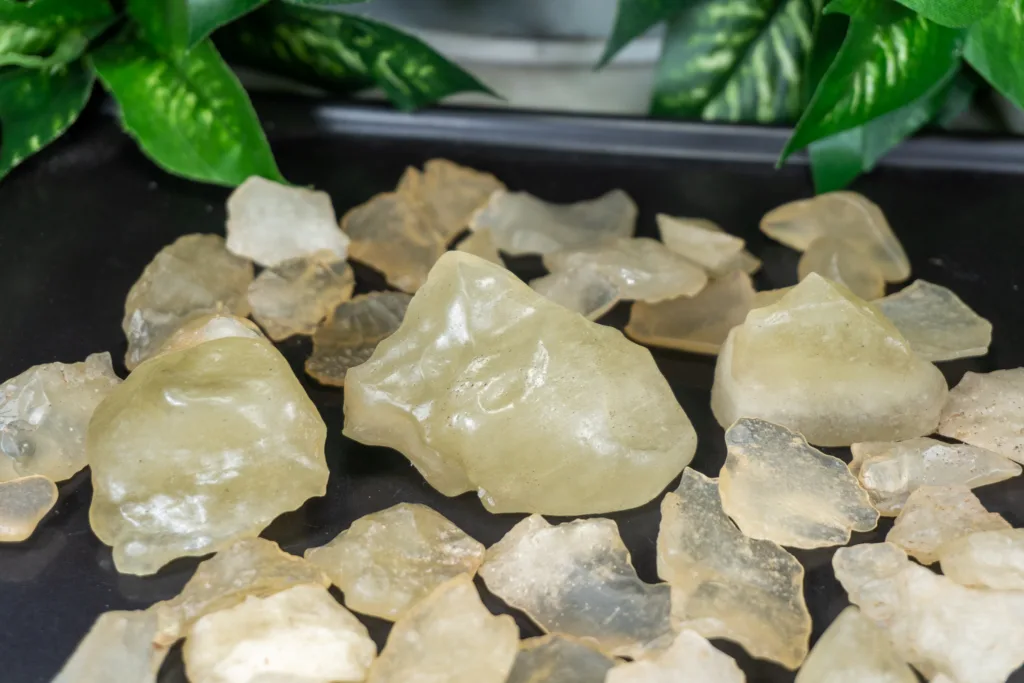
The discovery and exploration of Libyan Desert Glass (LDG) is a fascinating story that spans centuries and involves a blend of ancient Egyptian history, scientific research, and archaeological endeavors. Here’s an overview of how LDG was discovered and explored:
Ancient Use by Egyptians: Libyan Desert Glass has been known to humans for thousands of years, and it holds a significant place in the history of ancient Egypt. The ancient Egyptians used LDG to create jewelry, beads, and ornaments. They believed it had mystical and protective properties, referring to it as “the rock of god.” These ancient artifacts have been discovered in archaeological sites dating back to the Middle Kingdom period (around 2000-1700 BC).
Nineteenth-Century Explorations: The systematic exploration of the Libyan Desert and the discovery of LDG by Western explorers began in the 19th century. British geologist and explorer Frederick Augustus Swaisland is credited with bringing international attention to the region in the late 19th century. He collected specimens of Libyan Desert Glass and recognized its geological significance.
Scientific Investigations: In the early 20th century, the British Astronomer Royal, Sir Norman Lockyer, suggested that LDG might be related to meteorite impacts. His hypothesis laid the groundwork for scientific research into the origin of the glass. Subsequent studies confirmed that LDG was formed from a meteorite impact.
WWII and the Chondrite Hypothesis: During World War II, the Libyan Desert was the site of battles and military operations. The unique nature of LDG drew the attention of scientists involved in wartime research, including geologists and mineralogists. At this time, some scientists proposed that LDG was related to chondritic meteorites, which are composed of stony materials. This theory was later revised as more information became available.
Modern Scientific Research: In the latter half of the 20th century and into the 21st century, advanced scientific techniques, including electron microscopes and spectroscopy, were employed to study LDG. These studies confirmed the impact origin of the glass, and researchers were able to identify impact-related minerals and features in the LDG samples. The age of LDG was also determined to match the estimated age of the meteorite impact.
Archaeological Expeditions: In recent years, archaeological expeditions have explored the regions where LDG is found, in both Egypt’s Great Sand Sea and the Libyan Desert. These expeditions have aimed to uncover ancient trade routes and gather more information about how LDG was mined, used, and transported by ancient civilizations.
In summary, Libyan Desert Glass has a rich history of discovery and exploration. It has been known to humans for millennia and was used by the ancient Egyptians for jewelry and amulets. Western explorers and scientists in the 19th and 20th centuries played key roles in understanding its geological significance and impact origin. Modern scientific research, including advanced analytical techniques, has deepened our understanding of LDG, and ongoing archaeological expeditions continue to shed light on its historical use and cultural significance.
Characteristics of Libyan Desert Glass
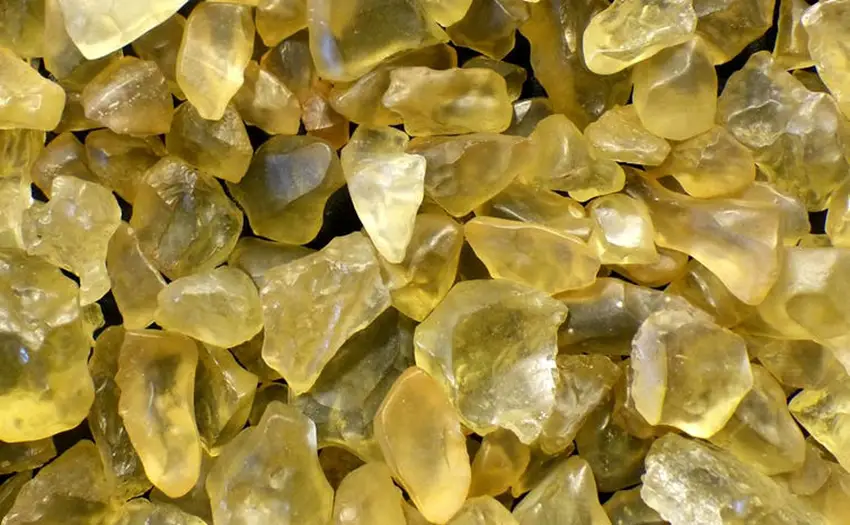
Libyan Desert Glass (LDG) possesses several distinctive characteristics that make it unique and easily identifiable. Here are the key characteristics of Libyan Desert Glass:
- Color: LDG is known for its striking yellow to greenish-yellow coloration, which can range from pale to deep hues. This color is a defining feature of Libyan Desert Glass and is a result of its specific chemical composition.
- Translucency: Libyan Desert Glass is generally translucent, allowing some light to pass through, but it can also be opaque, depending on the specific specimen. The degree of translucency varies among different fragments.
- Smooth and Polished Surface: LDG fragments often have a smooth and polished surface, which is a result of natural weathering processes in the desert environment. The wind-blown sand and abrasive action over time contribute to this characteristic.
- Conchoidal Fracture: When broken or fractured, Libyan Desert Glass exhibits a conchoidal fracture pattern, which is characterized by curved, glassy surfaces with concentric ridges. This type of fracture is common in glassy materials.
- Lack of Crystals: Unlike most minerals, LDG is not composed of crystalline structures. Instead, it is an amorphous glass with a disordered atomic arrangement, similar to other types of tektites.
- Occasional Bubble Inclusions: Some LDG specimens may contain small, spherical or elongated bubble inclusions, which are remnants of gas or vapor trapped during the glass’s formation.
- Low Water Content: LDG has an extremely low water content, which distinguishes it from many terrestrial glasses. This lack of water content contributes to its stability over millions of years.
- High Silica Content: Libyan Desert Glass is primarily composed of silica (silicon dioxide) with minor impurities. The silica content is responsible for its glassy nature and transparency.
- Impact Features: Microscopic analysis of LDG often reveals impact features, such as shocked minerals, maskelynite (a high-pressure mineral formed during impact events), and the presence of planar deformation features (PDFs) in quartz grains.
- Exposure to Desert Environment: LDG fragments found in the desert may exhibit desert patination, which is a thin layer of weathering and erosion caused by exposure to sand, wind, and abrasive forces.
- Variability in Shape and Size: Libyan Desert Glass fragments come in various shapes and sizes, from small, irregularly shaped pieces to larger, more angular specimens. Some LDG fragments are well-rounded and polished by natural processes, while others may have more angular edges.
- Lightweight: Libyan Desert Glass is relatively lightweight, with a low density compared to many other minerals or rocks. This characteristic can help distinguish it from other materials found in the same area.
Libyan Desert Glass’s unique combination of color, translucency, smooth surface, and its association with a meteorite impact event make it a sought-after material for collectors, researchers, and jewelers. Its unusual characteristics have contributed to its historical significance and scientific interest.
Collecting and Display
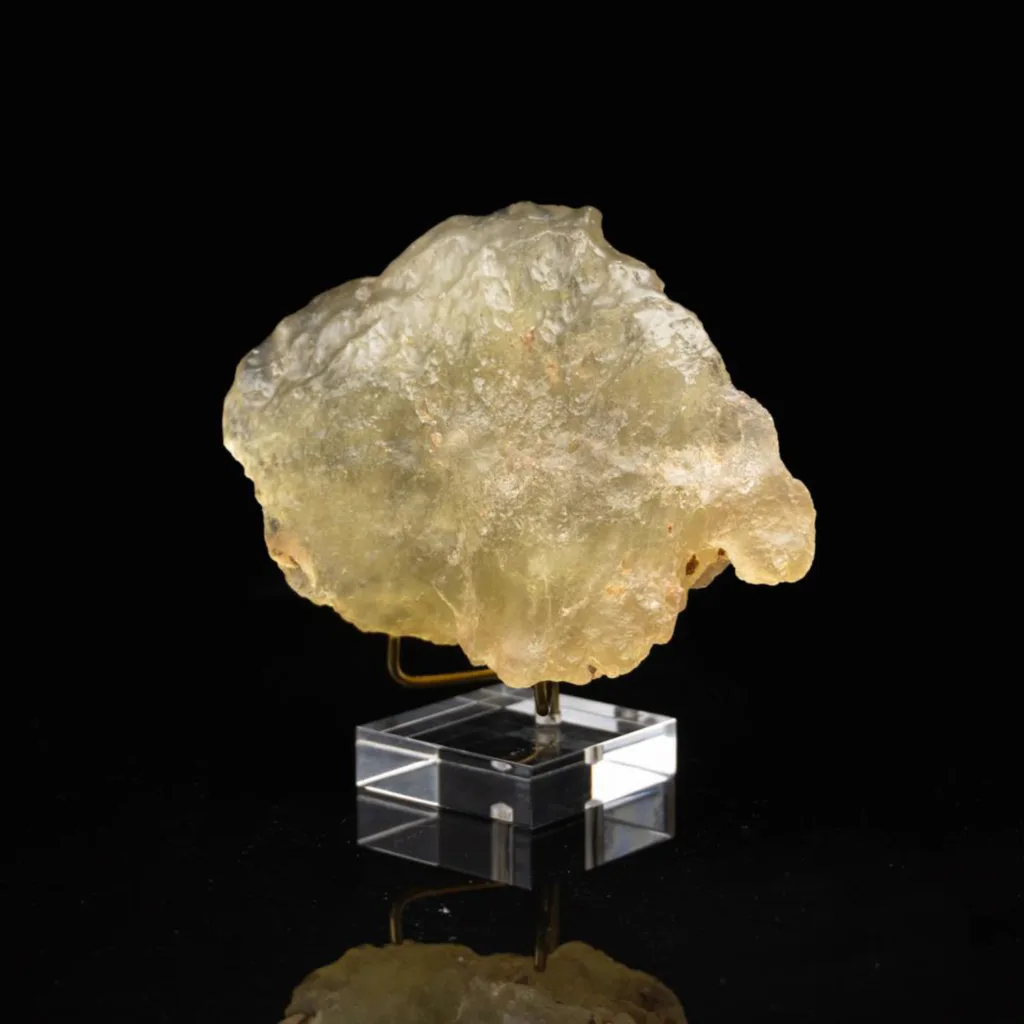
Collecting Libyan Desert Glass (LDG) can be an exciting endeavor for both amateur collectors and researchers. However, it’s important to approach the collection, preservation, and display of LDG specimens with care and responsibility. Here are some guidelines and considerations for collecting and displaying LDG, as well as its presence in museum exhibitions and the market:
Collecting Libyan Desert Glass:
- Respect Local Regulations: If you plan to collect LDG in the Libyan Desert or the Great Sand Sea in Egypt, be sure to adhere to local regulations and obtain any necessary permits. These remote desert regions may have restrictions on collecting, and it’s essential to respect both the environment and local authorities.
- Safety Precautions: Desert environments can be harsh and unforgiving. Ensure you are well-prepared with essential equipment, including ample water, navigation tools, and first-aid supplies. Protect yourself from extreme temperatures and sun exposure.
- Ethical Collecting: When collecting LDG, do so ethically and responsibly. Avoid damaging the desert ecosystem, and only collect what you can carry. Overcollecting can have a negative impact on the natural environment.
- Documentation: It’s helpful to document the collection location, date, and any relevant geological information for each specimen. This information can be valuable for scientific research and provenance.
- Cleaning and Preservation: LDG fragments found in the desert may have sand and debris on their surfaces. Carefully clean the specimens with soft brushes or water if necessary, but avoid using harsh chemicals or abrasive methods that could damage the glass.
Museum Exhibitions and Displays:
- Scientific Contribution: Many museums feature LDG in their mineral or meteorite exhibits. LDG specimens can contribute to public understanding of impact events and the Earth’s geological history.
- Labeling and Context: In a museum setting, LDG specimens should be properly labeled to provide context for visitors. Information on the meteorite impact, the formation of LDG, and its significance in geology and ancient civilizations can enhance the educational experience.
- Security: Due to the value and uniqueness of LDG, security measures must be in place to protect the specimens from theft or damage.
Market and Trade Considerations:
- Authenticity: When purchasing LDG in the market, it’s crucial to verify the authenticity of the specimens. There are counterfeit or imitation glass materials on the market, so be cautious and consider obtaining specimens from reputable sources or dealers.
- Provenance: Knowing the source of the LDG can add to its value. Specimens with documented provenance from recognized sources, such as museums or reputable dealers, may be more desirable to collectors.
- Price and Rarity: The price of LDG specimens can vary depending on size, quality, and rarity. Larger, well-preserved, or unusually shaped fragments are generally more valuable. Prices can range from relatively affordable to high-end, depending on the specimen’s characteristics.
- Legal Considerations: Be aware of any legal restrictions on the trade and export of LDG, especially if it originates from regions with specific regulations.
- Ethical Sourcing: Consider the ethical implications of your LDG purchases. Ensure that the specimens you acquire were collected and traded in a legal and ethical manner, respecting both local regulations and ethical standards.
In summary, collecting and displaying Libyan Desert Glass can be a rewarding experience, but it should be done responsibly, ethically, and with consideration of scientific and cultural importance. Museums play a significant role in educating the public about LDG, and collectors should take care to ensure the authenticity, provenance, and ethical sourcing of their specimens.
Application and Uses
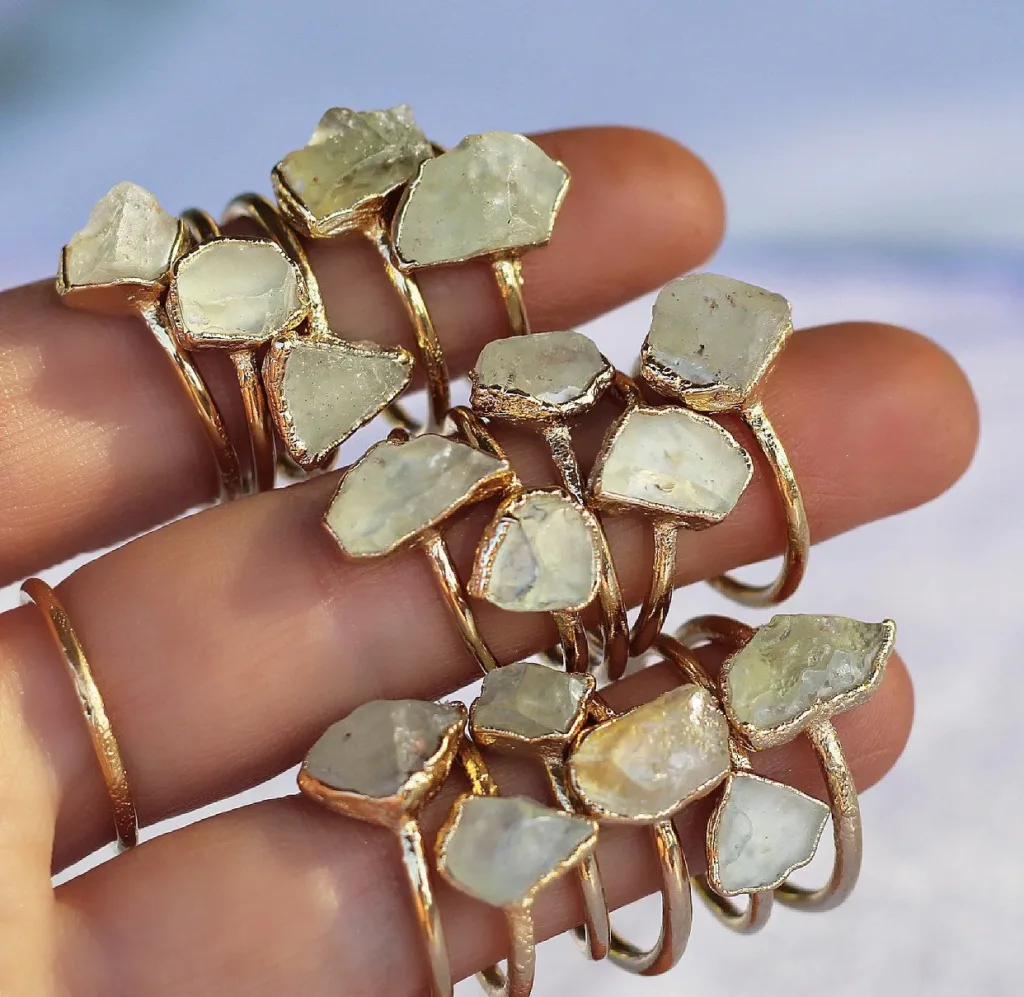
Libyan Desert Glass (LDG) has several applications and uses, both in scientific research and in the creation of jewelry and other decorative items. Here are the main applications and uses of LDG:
- Scientific Research:
- Planetary Geology: LDG is a valuable tool for planetary geologists and astrogeologists studying impact events on Earth and other celestial bodies. It helps researchers understand the effects of meteorite impacts and provides insights into impact crater formation.
- Dating Impact Events: By analyzing the age of LDG, scientists can date the meteorite impact event that created it. This information is crucial for establishing the geological history of a region.
- Shock Metamorphism: LDG contains shocked minerals and features formed during the intense heat and pressure of impact events. These are valuable for studying the geological processes that occur during high-velocity impacts.
- Jewelry and Decorative Items:
- Gemstones and Jewelry: LDG’s unique color and translucency make it an attractive material for creating gemstones and jewelry, including rings, necklaces, pendants, and earrings. Its distinct appearance is appreciated by collectors and individuals seeking one-of-a-kind pieces.
- Amulets and Talismans: Historically, LDG has been used to create amulets and talismans. Some people believe in its mystical and protective properties, and they use LDG jewelry for spiritual or superstitious reasons.
- Display and Collectibles:
- Collector’s Items: LDG specimens, especially those with unusual shapes, features, or historical significance, are sought after by collectors of minerals, meteorites, and natural curiosities. Some collectors focus on acquiring LDG fragments with specific characteristics or provenance.
- Display and Decor: LDG specimens can be used as decorative items or conversation pieces in homes, offices, and museums. Their unique appearance and association with meteorite impacts make them appealing for display.
- Educational Tools:
- Museums and Exhibits: LDG is often featured in museums and educational exhibits, where it is used to teach the public about impact events, meteorites, and the geological history of our planet. The glass’s remarkable appearance and story make it engaging for educational purposes.
- Historical and Archaeological Studies:
- Ancient Artifacts: LDG has been found in ancient Egyptian archaeological sites, incorporated into jewelry and amulets. Its presence in these historical artifacts provides insights into the use of LDG by ancient civilizations and their beliefs regarding its properties.
- Mineralogical Studies:
- Mineralogy and Petrology: LDG is studied by mineralogists and petrologists to understand its chemical composition, structure, and formation processes. It serves as a case study in the study of tektites and natural glasses.
- Cultural and Symbolic Uses:
- Cultural and Symbolic Significance: Some individuals and cultures may use LDG for cultural or symbolic reasons, believing in its protective or spiritual properties. It can be worn as jewelry or kept as a symbol of luck, protection, or a connection to ancient history.
It’s important to note that LDG is a finite resource, and its collection should be done responsibly and ethically, respecting local regulations and the environment. Additionally, the authenticity and provenance of LDG specimens are essential considerations, especially when used in scientific research, as well as for collectors and jewelry makers.




































